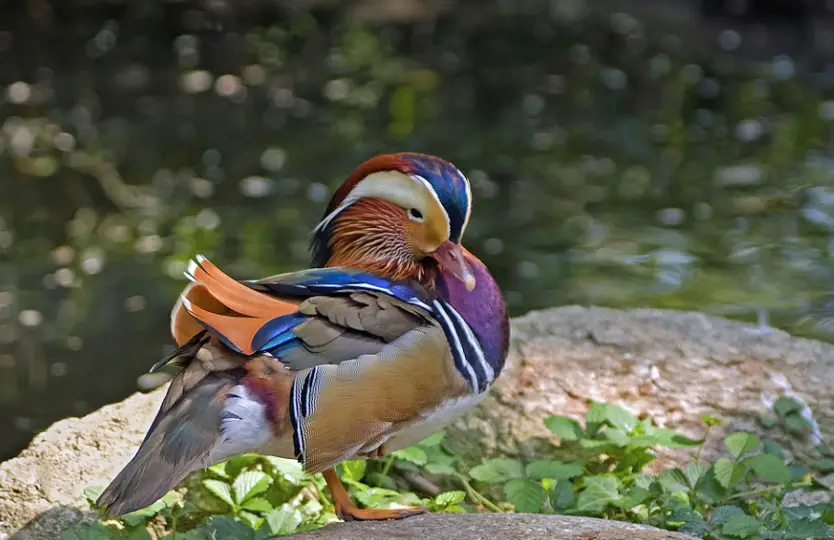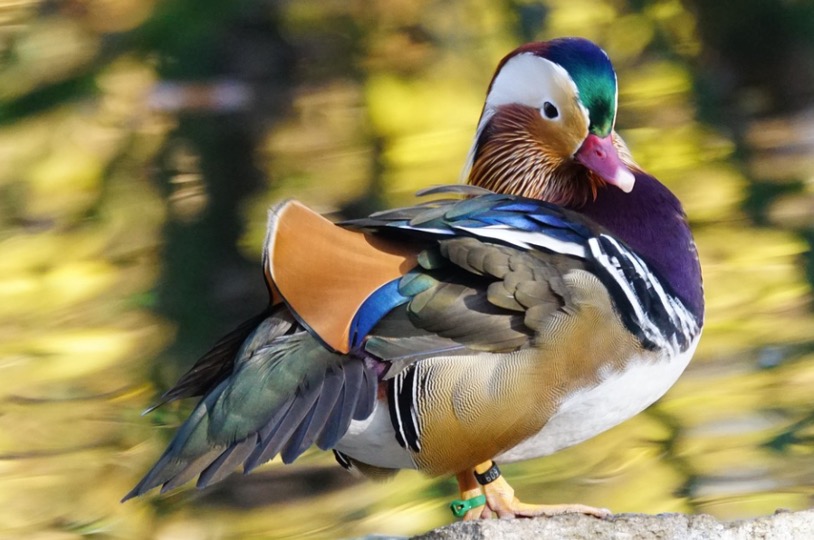Mandarin Duck: All You Need To Know
The Mandarin duck is a beautiful bird which belongs to the kingdom of Animalia, phylum Chordata, and class Aves. Its genus is Aix and its species is Aix galericulata. Its length is 21.0 to 24.5 cm and it weighs 1 to 3 pounds. It lives in wooded, rocky ponds and streams, with a lifespan of up to 12 years.

Mandarin Duck Description
The mandarin duck (Aix galericulata), also known as yuan-yang in Chinese, is a lovely bird found in China, Japan, and Siberia. It is a close cousin of the wood duck in North America.
The male, like most ducks, is significantly more colourful and has stunning plumage than the female. The male has a red/orange face with whiskers and a white crescent over his eye. His bill has a bright crimson colour. Red, orange, brown, green, and purple make up the rest of his plumage.
The males wear a sail of feathers across their backs during the mating season. Females, on the other hand, have grey and brown feathers with a pale pink beak. On the female, a white eye-ring is also seen on her.

Pools, lakes, rivers, fast-flowing streams, marshes, and swamps bordered by lush deciduous woodland are home to these birds. Mandarin ducks are native to eastern Siberia, north-eastern China, South Korea, and Japan, where they can be found. South-eastern China and Taiwan are home to several birds during the winter.
North Carolina and California are among the states where these birds have been introduced. They’ve also been brought to the United Kingdom, where there are about 1000 mating pairs. Mandarin ducks are gregarious creatures. They mate in couples and develop relationships that last for a season or longer, and they will sometimes overwinter in flocks.

Mandarin ducks have a complicated courting ritual. They establish couples early in the mating season and then begin looking for a nest. On this nest-hunting expedition, the male will follow the female.
The ducks make their nests in holes in trees that may reach heights of 32.8 feet (10 metres). Between nine and twelve eggs are laid by the female. The eggs hatch within a few hours of each other after a four-week period of incubation.
By calling to them from the ground, the mother will encourage them out of the nest. Before moving to eating grounds, the chicks will free fall to the earth from the nest. Surprisingly, the ladies usually make it through this voyage unharmed.
The chicks are ready to fledge about 45 days after hatching and will fly off to join another flock. Habitat loss is the most serious danger to mandarin duck populations. Raccoons, minks, eagles, snakes, and otters all hunt on them.
Fun Facts About Mandarin Duck!
Due to its stunning plumage, the Mandarin duck is regarded as one of the most attractive duck species. In China, Japan, and Korea, it is also a symbol of love and faithfulness since it typically establishes lasting ties with its mate.
Mandarin ducks have been known to couple up for several mating seasons, and in some circumstances, these connections have been observed to span a lifetime. Aside from these characteristics, these ducks demonstrate a number of other fascinating biological principles. Let’s look at it more closely.

ZW Sex-determination System
Sex is defined by the existence of particular chromosomes in humans and many other animal species. The XY system in humans determines an individual’s sex based on a pair of chromosomes.
Males and females have two different types of sex chromosomes, with females having two of the same type (XX) and males having two different types (XY). Mandarin ducks, like other birds, have a ZW sex-determination system that differs from the XY system found in most mammals.
Females have two types of sex chromosomes (ZW) in the ZW system, while males have two that are similar (ZZ). This means that, unlike the XY system, the sex of the progeny is determined by the female’s gametes, or eggs, rather than the male’s sperm.
In nature, the ZW sex-determination method is fairly common. Researchers have discovered that the ZW system determines the sex of progeny in a variety of fish, crustaceans, and insects, including moths and butterflies.

Males Mandarin Duck Molt After Breeding
While the male duck stays around during the incubation stage, he departs from the female duck to raise the babies once the eggs hatch. He molts and sheds his bright plumage during this time.
During this period, the male also loses his primary flying feathers, rendering him unable to fly. The male has lost his bright plumage and is now brown and grey in hue, similar to the female, which helps him blend in with his surroundings and hide from predators.
Mandarin Duck: a Dabbling Ducks
The mandarin duck is one of eight genera and 50–60 species of dabbling ducks. These ducks are named after the manner in which they eat, yet they differ from other duck species in a number of ways.
Dabbling ducks prefer shallow water, such as flooded fields and marshes. Instead of diving, they feed by tilting up in the water with their head down and their back end out of the water. Dabbling refers to the way they feed, which involves moving their bill around in the water. They have broadbills and float high above the water’s surface.
They can feed on little insects that live on the water’s surface and forage through floating algae and plants in this manner. The legs of dabbling ducks are more central than those of diving ducks, allowing them to walk more easily on land, where they may also feed. They are strong fliers who can take off straight from the water, unlike diving ducks.
Mandarin Duck Citations
- Metastatic malignant melanoma in a mandarin duck (Aix galericulata). Avian Dis . Oct-Dec 1993;37(4):1158-62.
- Subclinical Infection and Transmission of Clade 2.3.4.4 H5N6 Highly Pathogenic Avian Influenza Virus in Mandarin Duck ( Aix galericulata) and Domestic Pigeon ( Columbia livia domestica). Viruses . 2021 Jun 4;13(6):1069.
- Reassortant Clade 2.3.4.4 Avian Influenza A(H5N6) Virus in a Wild Mandarin Duck, South Korea, 2016. Emerg Infect Dis . 2017 May;23(5):822-826.







